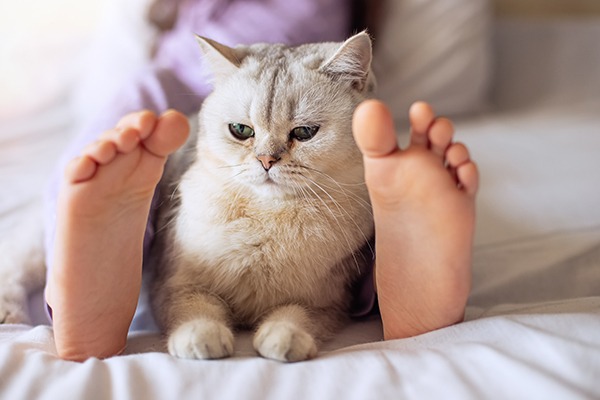Background
Arthritis refers to the inflammation of one or more joints. The most common type of arthritis in dogs and cats is osteoarthritis, also known as a degenerative joint disease (DJD). In pets with osteoarthritis, the cartilage lining at the end of the bone deteriorates and the surrounding fluid thins, causing inflammation, pain, and stiffness where the bones rub together. The bone can wear down, develop bone spurs, or even chip as osteoarthritis progresses.
Risk Factors
While osteoarthritis can have multiple causes, it typically develops secondary to a musculoskeletal disorder, such as hip dysplasia, cranial cruciate ligament disease (CCLD), elbow dysplasia, osteochondrosis, or a luxating patella (kneecap dislocation). The degeneration of joints can also be caused by trauma or an infection such as Lyme Disease. Other contributing factors include genetics, a higher body weight, age, sex, neuter status, exercise, and diet.
Signs
Signs of osteoarthritis in dogs include:
- Lameness or limping
- Decreased activity
- Inability to jump
- Stiffness
- Difficulty with stairs
- Changes in behavior (less social)
Signs of osteoarthritis in cats include:
- Hesitancy to jump
- Urination/defecation outside the litter box
- Poor grooming
- Increased sleeping
- Stiffness when rising
- Changes in behavior (increased irritability)
Diagnosis
A veterinarian will perform a physical exam of the joints to assess if there are any swollen joints, painful areas, or reduced muscle mass. An x-ray can confirm the diagnosis, which may show the presence of swelling of tissue around the joint, increased fluid within the joint, or changes to the bone such as bone thickening or bone spurs.
Additional tools include a CT scan or an MRI to diagnose the underlying cause of arthritis by assessing the bone structure and surrounding tissues. A joint tap can be used to assess the joint fluid if an infection or autoimmune condition is suspected.
Treatment
While arthritis cannot be cured, it can be effectively managed. Both surgical and non-surgical treatment options are available and should be discussed with your veterinarian. Depending on the underlying cause, your veterinarian may recommend any of the following:
- Pain Management: Non-steroidal anti-inflammatory drugs (NSAIDs) are commonly prescribed for pain management. Adjunctive pain medications are also available for pets that cannot tolerate NSAIDs.
- Surgery: Surgical options can be the best treatment choice depending on the underlying cause of arthritis. Surgical repair of damaged ligaments (such as a ruptured CCL) or damaged bone may decrease pain and improve joint function. In severe cases of arthritis, hip or knee replacements are also an option.
- Rehabilitation: Veterinarians certified in animal rehabilitation work closely with you and your veterinary team to improve your pet’s joint mobility, increase muscle mass, and reduce pain through a variety of therapeutic exercises and techniques.
- Weight Loss & Diet: A high body weight puts additional force on the joints and contributes to inflammation. Weight loss can improve your pet’s mobility and take additional pressure off the joints. Your veterinarian may recommend a diet formulated to promote weight loss as well as foods formulated to support joint health.
- Activity Modification: Regular exercise is an important component of your pet’s overall treatment plan. It not only helps facilitate weight loss, but it strengthens muscles that become weak due to inactivity as a result of the pain of arthritis. Certain high-impact activities, such as running or jumping, are not recommended and should be replaced with regular, low-impact exercises such as walking or swimming.
- Supplements: The most commonly recommended joint supplements include chondroitin sulfate, glucosamine sulfate, and omega-3 fatty acids.
- Joint Injections: To slow the progression of arthritis, a veterinarian may recommend joint injections, especially if other treatment options are unable to sufficiently reduce pain. The four general types of joint injections include platelet-rich plasma (PRP), stem cell therapy, and hyaluronic acid (HA).
- Acupuncture: Developed in China over 3,000 years ago, acupuncture uses small needles inserted into specific points on the body to achieve a healing effect. According to Chinese medical philosophy, the disease is a result of an imbalance of energy in the body. Acupuncture is believed to balance this energy and assist the body in the healing process. In Western terms, acupuncture stimulates nerves, increases blood circulation, relieves muscle spasms, and releases hormones such as endorphins that aid in pain control.
Prevention
While osteoarthritis typically develops secondary to a musculoskeletal disorder, regular exercise, maintaining healthy body weight, and joint supplements are all ways of keeping your pet’s joints healthy. In a landmark study, dogs managed with calorie restriction lived longer and had fewer chronic diseases like arthritis than dogs fed normally.

